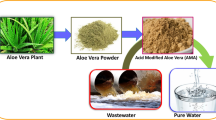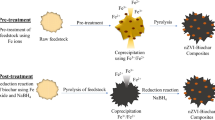Abstract
Groundwater contamination by non-metallic inorganic contaminants has become a severe problem to the human kind and its healthy survival. Nitrate contamination of drinking water has become a major health threat in many countries of the world including India and this issue needs to be resolved through developing advance technology to scale down the nitrate concentration and to make the water fit for drinking. With the ultimate objective of developing an inorganic and sustainable sorptive media for nitrate abatement from drinking water, hydrous bismuth oxide (HBO) has been synthesized and studied as an adsorbent for aqueous medium in the present work. Hydrous bismuth oxides based adsorbents are found to have nitrate sorptive properties along with their possible application in drinking water treatment. In an attempt of improving the potentials of HBO, incorporation of cations such as copper, iron and two transition metals each of which has vividly been used in the preparation of bi-metallic adsorbents as well as polymeric ligand exchangers. Calcium and Magnesium were included for their wide availability and possible value addition towards the purpose. HBO adsorbent mixed with cations, which has shown highest nitrate sorptive potential was characterized using X-Ray diffraction pattern, Scanning electron microscopy and Fourier Transform Infrared spectroscopy analyses. It was observed that incorporation of these individual cations, the Mg and Ca did not show any improvement whereas the presence of Fe and Cu within the matrix of HBO has shown significant improvement in nitrate sorption potential of HBO and it was inferred that presence of Ca, Mg and Fe appear to be helpful in the formation of polymeric structures. Scherrer crystallite size slightly improved in presence of Mg and Fe.
Similar content being viewed by others
References
World Health Organization, Guidelines for Drinking Water Quality. Recommendations, 2nd ed., Geneva, 2002.
Ievleva, O.S., Badekha, V.P., Goncharuk, V.V., The flow chart of purifying natural waters of nitrate ions using pressure-driven methods, J. Water Chem. and Technol., 2014, vol. 36, no. 5, pp. 241–246.
Singh, B. and Singh, Y., Balanced fertilization for environmental quality, Fertilizer News., 2004, vol. 49, pp. 107–113.
Matsuska, O.V., Paranyak, R.P., and Gumnitskii, Ya.M., Adsorption of wastewater components by natural sorbents, J. Water Chem. and Technol., 2010, vol. 32, no. 4, pp. 218–222.
Fewtrell, L., Drinking-water nitrate, methemoglobinemia, and global burden of disease: a discussion, Environ. Heal. Persp., 2004, vol. 112, no. 14, pp. 1371–1374.
Samatya, S., Kabay, N., Yuksel, U., et al., Removal of nitrate from aqueous solution by nitrate selective ion exchange resins, React. Funct. Polymer., 2006, vol. 66, no. 11, pp. 1206–1214.
Bureau of Indian Standards, Specifications for Drinking Water, IS: 10500:1991. BIS, New Delhi, 1991/2003.
Kumar, M. and Chakraborty, S., Chemical denitrification of water by zerovalent magnesium powder, J. Hazard. Mater., 2006, vol. 135, no. 1/3, pp. 112–121.
Ahn, S.C., Oh, S.Y., and Cha, D.K., Enhanced reduction of nitrate by zero-valent iron at elevated temperatures, J. Hazard. Mater., 2008, vol. 156, no. 1/3, pp. 17–22.
Samatya, S., Mizuki, H., Ito, Y., et al., Removal of nitrate from aqueous solution by nitrate selective ion exchange resins, React. Funct. Polym., 2010, vol. 70, pp. 63–68.
Milmile, S.N., Pande, J.V., Karmakar, S., et al., Equilibrium isotherm and kinetic modeling of the adsorption of nitrates by anion exchange Indian NSSR resin, Desalination, 2011, vol. 276, no. 1/3, pp. 38–44.
Schoeman, J.J. and Steyn, A., Nitrate removal with reverse osmosis in a rural area in South Africa, Desalination, 2003, vol. 155, pp. 15–26.
Hell, F., Lahnsteiner, J., Frischherz, H., and Baumgartner, G., Experience with full scale electrodialysis for nitrate and hardness removal, Desalination, 1998, vol. 117, no. 1/3, pp. 173–180.
Hasnat, M.A., Ahamad, N., Nizam Uddin, S.M., and Mohamed, N., Silver modified platinum surface/H+ conducting Nafion membrane for cathodic reduction of nitrate ions, Appl. Surface Sci., 2012, vol. 258, pp. 3309–3314.
Healy, M.G., Ibrahim, T.G., Lanigan, G.J., et al., Nitrate removal rate, efficiency and pollution swapping potential of different organic carbon media in laboratory denitrification bioreactors., Ecol. Eng., 2012, vol. 40, pp. 198–209.
Cameron, S.G. and Schipper, L.A., Hydraulic properties, hydraulic efficiency and nitrate removal of organic carbon media for use in denitrification beds, Ecol. Eng., 2012, vol. 41, pp. 1–7.
Zhao, B., Zhang, Y., Dou, X., et al., Granulation of Fe-Al-Ce trimetal hydroxide as a fluoride adsorbent using the extrusion method, Chem. Eng. J., 2012, vol. 185/186, pp. 211–218.
Shrimali, M. and Singh K.P., New methods of nitrate removal from water, J. Environ. Pollut., 2001, vol. 112, no. 3, pp. 351–359.
Kapoor, A. and Virarghavan, T., Nitrate removal from drinking water. A review, J. Environ. Eng., 1997, vol. 123, no. 4, pp. 371–380.
Devi, R.R., Umlong, I.M., and Raul, P.K., Defluoridation of water using nano-magnesium oxide, J. Exp. Nanosci., 2014, vol. 9, pp. 512–524.
Goncharuk, V.V., Pshinko, G.N., and Timoshenko, T.G., Defluorination of natural waters by filtration through glauconite treated with aluminum salts, J. Water Chem. and Technol., 2008, vol. 30, no. 6, pp. 351–357.
Huang, Y.H. and Zhang, T.C., Effects of low pH on nitrate reduction by iron powder, Water Res., 2004, vol. 38, pp. 2631–2642.
Islam, M. and Patel, R., Nitrate sorption by thermally activated Mg/Al chloride hydrotalcite-like compound, J. Hazard. Mater., 2009, vol. 169, pp. 524–531.
Hou, M., Tang, Y., Xu, J. et al., Nitrate reduction in water by aluminum—iron alloy particles catalyzed by copper, J. Environ. Chem. Eng., 2015, vol. 3, pp. 2401–2407.
Mehrabi, N., Soleimani, M., Yeganeh, M.M., and Sharififard, H., Parameter optimization for nitrate removal from water using activated carbon and composite of activated carbon and Fe2O3 nanoparticles, RSC Adv., 2015, vol. 5, pp. 51470–51482.
Singh, P.K., Banerjee, S., Srivastava, A.L., and Sharma, Y.C., Kinetic and equilibrium modeling for removal of nitrate from aqueous solutions and drinking water by a potential adsorbent, hydrous bismuth oxide, RSC Adv., 2015, vol. 5, pp. 35365–35376.
Srivastav, A.L., Singh, P.K., Weng, C.H., and Sharma, Y.C., Novel adsorbent hydrous bismuth oxide for the removal of nitrate from aqueous solutions, J. Hazard. Toxic Radioact. Waste, 2014, vol. 19, no. 2, pp. 04014028.
Srivastava, A.L., Singh, P.K., Srivastava, V., and Sharma, Y.C., Application of a new adsorbent for fluoride removal from aqueous solutions, J. Hazard. Mater., 2013, vol. 263, pp. 342–352.
Srivastav, A.L., Singh, P. K., and Sharma, Y.C., Synthesis of a novel adsorbent, hydrous bismuth oxide (HBO2) for the removal of fluoride from aqueous solutions, Desal. Water Treat., 2015, vol. 55, pp. 604–614.
Ranjan, M., Srivastav, A.L., and Shaktibala, Effects of addition of cationic ligands in hydrous bismuth oxide on removal of fluoride from aqueous solutions, Current Sci., 2015, vol. 108, no. 9, pp. 1673–1682.
Yan, L., Hu, S., and Jing, C., Recent progress of arsenic adsorption on TiO2 in the presence of coexisting ions: a review, J. Environ. Sci., 2016, vol. 49, pp. 74–85.
Pérez, J., Toledo, L., Campos, C.H., et al., Organic-inorganic interpenetrated hybrids based on cationic polymer and hydrous zirconium oxide for arsenate and arsenite removal, Chem. Eng. J., 2016, vol. 287, pp. 744–754.
Fristche, U., Removal of nitrates and other anions from water by yellow bismuth hydroxide, J. Environ. Sci. Health, 1993, vol. A28(9), pp. 1903–1913.
Singh, P.K., Nitrate removal from water by bismuth based media, Ph.D. Thesis, Dept. Civil Eng., I.I.T. Kanpur, India, 1999.
Singh, P.K. and Ghosh, D.K., Waste recycling and resource management in the developing world, B.B. Jana, R.D. Banerjee, B. Guterstam, and J. Heeb, Eds., University of Kalyani, India and Int. Ecol. Eng. Soc. Switzerland.
Singh, P.K., Srivastav, A.L., Ghosh, D.K., and Sharma, Y.C., Preparation and properties of hydrous bismuth oxides for nitrate removal from aqueous solutions, Desal. Water Treat., 2012, vol. 40, no. 1/3, pp. 144–152.
An, B., Steinwinder, T.R., and Zhao, D., Selective removal of arsenate from drinking water using a polymeric ligand exchanger, Water Res., 2005, vol. 39, pp. 4993–5004.
American Public Health Association (APHA). American Water Works Association and Water Environment Federation, Standard methods for examination of water and wastewater, 20th ed., Washington D.C., USA, 1998.
Huang, C.P. and Ostovic, F.B., Removal of Cd(II) by activated carbon adsorption, J. Environ. Eng. Div., ASCE, 1978, vol. 104, pp. 863–878.
JCPDS. International Centre for Diffraction Data 12 Campus Boulevard, Newtown Square, PA 19073-3273. U.S.A., 2003.
Ramli, Tze, C.M., and Hin, T.Y., Effect of sodium hydroxide concentration on the physico chemical characteristic of α-Bi2O3 nanocrystals, Sol. State Sci. Technol., 2007, vol. 15, no. 1, pp. 30–42.
Fruth, V., Popa, M., Berger, D., et al., Phases investigation in the antimony doped Bi2O3 system, J. Eur. Ceram. Soc., 2004, vol. 24, pp. 1295–1299.
Zhang, W.L., Tian, Z.X., Zhang, N., and Li, X.Q., Nitrate pollution of groundwater in northern China, Agric. Ecosyst. Environ., 1996, vol. 59, pp. 223–231.
Milorad D., Caki, Nikoli, Goran, S., and Ili, L.A., FTIR spectra of iron(III) complexes with dextran, pullulan and inulin oligomers, Bull. Chem. Technol. Macedonia, 2002, vol. 21, no. 2, pp. 135–146.
Huang, H., Tian, M., Yang, J., et al., Stearic acid surface modifying Mg(OH)2: Mechanism and its effect on properties of ethylene vinyl acetate/Mg(OH)2 composites, J. Appl. Polymer Sci., 2007, vol. 107, pp. 3325–3331.
Bosch Reig, F., Gimeno Adelantado, J.V., Moya Moreno, M.C.M., FTIR quantitative analysis of calcium carbonate (calcite) and silica (quartz) mixtures using the constant ratio method. Application to geological samples, Talanta, 2002, vol. 58, pp. 811–821.
Muhamad, E.N., Irmawati, R., Abdullah, A.H., et al., Effect of number of washing on the characteristics of copper oxide nanopowders, Malaysian J. Anal. Sci., 2007, vol. 11, no. 1, pp. 294–301.
Wu, X., Zhang, Y., Dou, X., and Yang, M., Fluoride removal performance of a novel Fe-Al-Ce trimetal oxide adsorbent, Chemosphere, 2007, vol. 69, pp. 1758–1764.
Author information
Authors and Affiliations
Corresponding author
Additional information
The text was submitted by the authors in English.
About this article
Cite this article
Ranjan, M., Singh, P.K., Srivastav, A.L. et al. Adsorptive Properties of Cation Added Hydrous Bismuth Oxide on Nitrate Sorption. J. Water Chem. Technol. 41, 283–291 (2019). https://doi.org/10.3103/S1063455X19050035
Received:
Revised:
Accepted:
Published:
Issue Date:
DOI: https://doi.org/10.3103/S1063455X19050035




